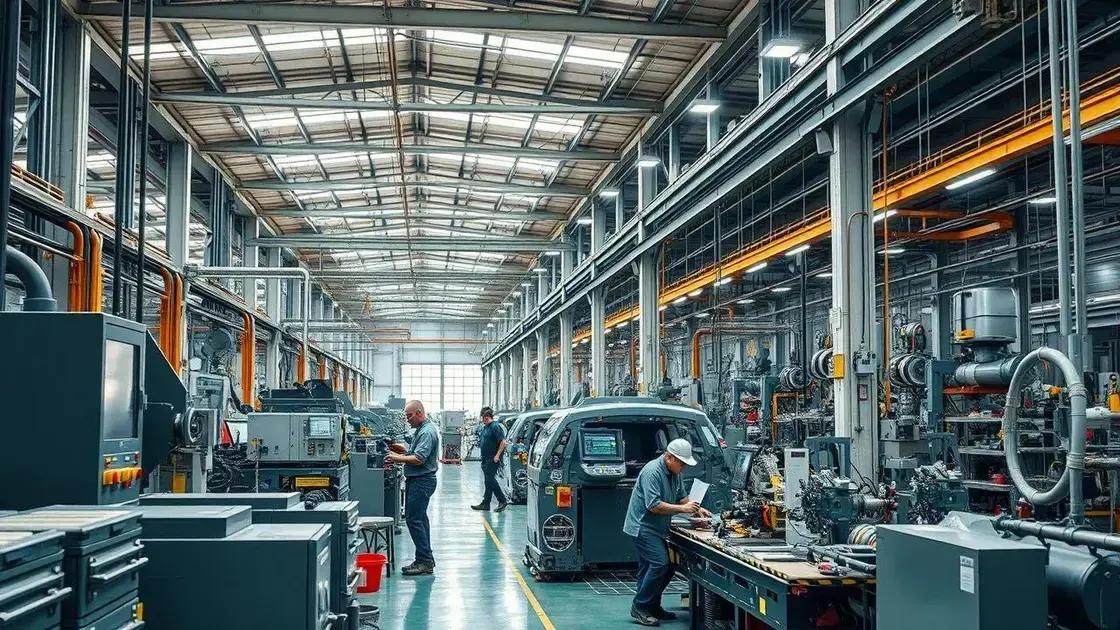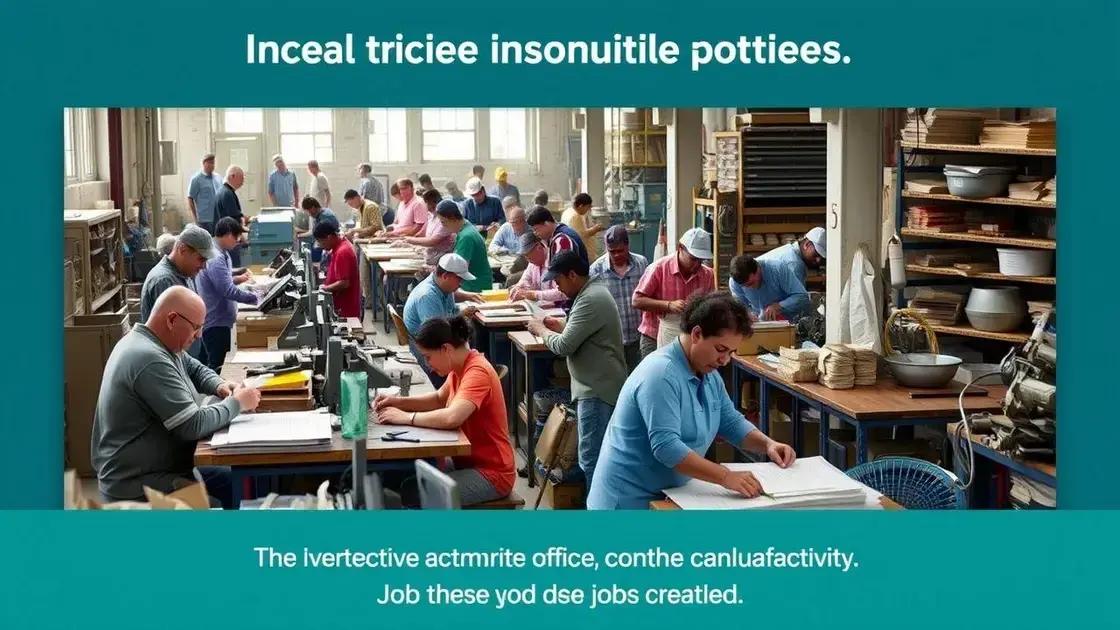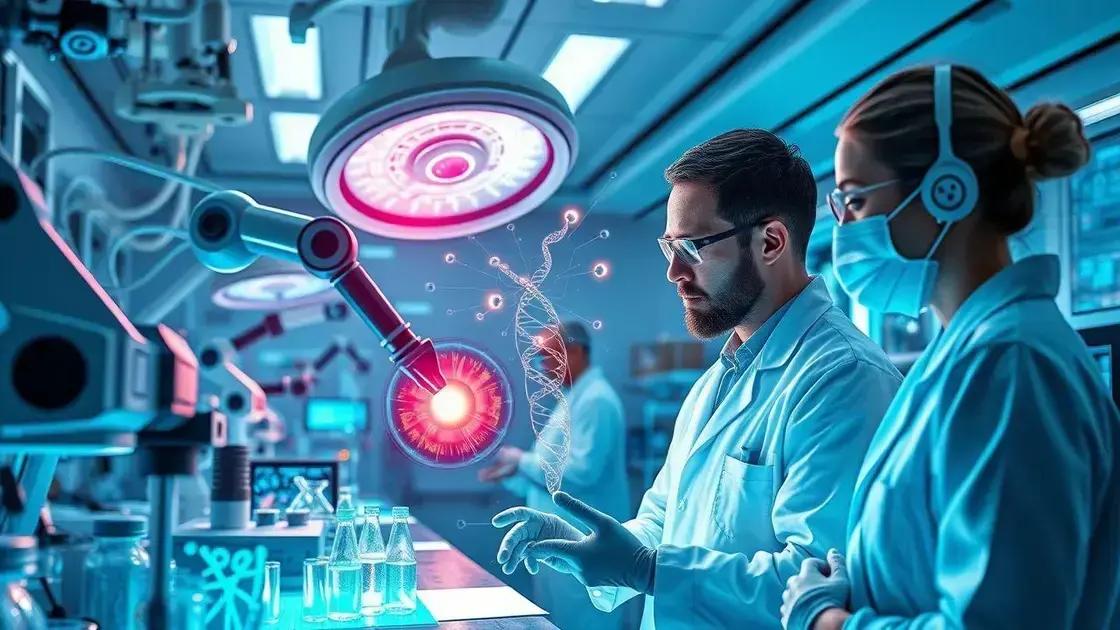Biden’s initiative to revitalize American manufacturing

Anúncios
Biden’s initiative to revitalize American manufacturing focuses on boosting local jobs, enhancing supply chains, promoting sustainable practices, and leveraging advanced technologies to strengthen the U.S. manufacturing sector and ensure its global competitiveness.
Biden’s initiative to revitalize American manufacturing is garnering attention as a crucial step towards rebuilding the industry. Have you wondered how this affects our economy and communities?
Anúncios
Overview of Biden’s manufacturing initiative
The Overview of Biden’s manufacturing initiative highlights key strategies that aim to transform American industry. This initiative seeks to promote growth and innovation in various sectors, ensuring job creation and sustainability. The goal is to make the U.S. a leader in manufacturing once again.
Key Components of the Initiative
Several components are central to this initiative, including investment in technology, sustainable practices, and workforce development. Here are some focal points:
Anúncios
- Investment in R&D: Funding research to drive innovation in manufacturing technology.
- Boosting Local Production: Encouraging companies to produce goods locally, reducing reliance on foreign imports.
- Workforce Training: Offering programs to equip workers with the skills needed in modern manufacturing environments.
Another significant aspect is the emphasis on clean energy and sustainability. This initiative aims to ensure that manufacturing growth does not come at the expense of our environment. Companies are being encouraged to adopt eco-friendly practices, which can help to attract investments and develop competitive advantages.
Challenges in Implementation
Despite its promise, there are challenges to the successful implementation of this initiative. Incentives must be carefully structured to ensure they effectively support companies without encouraging complacency. Additionally, the transition to new practices can be innovative yet disruptive, requiring time and dedicated resources.
The ultimate vision of Biden’s initiative is to create a robust manufacturing sector that not only supports the economy but also addresses environmental concerns. By focusing on sustainability and addressing workforce needs, the initiative aims to adapt the U.S. manufacturing landscape for the future effectively.
Key goals and objectives of the initiative
The key goals and objectives of the initiative aim to reshape American manufacturing to meet today’s challenges. By focusing on innovation, the initiative seeks to create a more resilient and competitive manufacturing sector.
Strengthening the Supply Chain
One primary goal is to enhance domestic supply chains. This includes reducing dependency on foreign sources for critical components. A strong supply chain will not only improve reliability but also reduce costs in the long run.
- Invest in domestic production: Encourage manufacturers to procure materials locally.
- Develop alternative sourcing strategies: Identify multiple suppliers to avoid disruptions.
- Incentivize collaborations: Foster partnerships among businesses to share resources.
Another significant objective is to create high-paying jobs. The initiative places emphasis on workforce development by providing training programs that equip workers with necessary skills. This approach not only helps individuals but also strengthens the workforce overall.
Promoting Sustainable Practices
Additionally, the initiative aims to promote sustainable manufacturing practices. This includes reducing pollution and encouraging the use of renewable energy sources. Manufacturers are urged to adopt eco-friendly technologies and practices, which can enhance their competitiveness while benefiting the environment.
Engaging in research and development is also a critical component of the initiative. By investing in R&D, the U.S. can remain at the forefront of technological advancements in manufacturing. This helps in developing new products and improving processes to boost efficiency.
Overall, the initiative strives to create a manufacturing environment that supports growth, sustainability, and innovation.
Impact on local economies and job creation

The impact on local economies and job creation from Biden’s manufacturing initiative is profound and far-reaching. By revitalizing the manufacturing sector, communities across the country stand to benefit significantly.
Boosting Local Employment
One of the main outcomes of this initiative is increased job opportunities. As manufacturers expand and new companies emerge, the demand for skilled workers rises. This stimulates local job markets, providing opportunities for residents and reducing unemployment rates.
- High-paying positions: Many manufacturing jobs offer competitive salaries, contributing to economic security.
- Skill development: Training programs prepare workers for roles in modern manufacturing, increasing employability.
- Support for local businesses: Increased manufacturing can lead to growth in local supply chains and service industries.
As manufacturing expands, it can lead to investments in infrastructure. Improvements in transportation, utilities, and technology not only benefit manufacturers but also enhance community resources. This creates a strong foundation for future growth.
Strengthening Community Resilience
Moreover, having a robust manufacturing sector enhances community resilience. It reduces reliance on external economies, enabling local areas to thrive independently. When local businesses are successful, they contribute taxes that support public services, improving the quality of life for residents.
Innovation plays a key role in this transformation. By adopting new technologies, manufacturers can increase productivity, which often results in business growth. This cycle of innovation and expansion fosters a dynamic economic environment.
The positive impact of this initiative on local economies and job creation reflects a broader shift towards prioritizing American manufacturing. Investing in this sector creates not just jobs, but also a sustainable future.
Challenges facing American manufacturers
The challenges facing American manufacturers are significant and require strategic solutions. As the industry evolves, manufacturers must navigate various issues that can hinder growth and sustainability.
Supply Chain Disruptions
One major challenge is the frequent disruptions in supply chains. Events such as natural disasters, geopolitical tensions, or pandemics can impact the availability of materials. This causes delays and increases production costs.
- Global dependency: Many manufacturers rely on foreign suppliers, making them vulnerable to external factors.
- Logistical issues: Transportation setbacks can slow down the entire manufacturing process.
- Inconsistent quality: Varied supplier standards may lead to product inconsistencies.
Another challenge is the competition from overseas manufacturers. Companies from countries with lower labor costs often can offer cheaper products, making it difficult for American manufacturers to compete on price alone.
Workforce Shortages
Additionally, there is a growing shortage of skilled labor in the U.S. Manufacturing technology is becoming more advanced, requiring employees to possess new skills. As older workers retire, fewer young people enter the field, leading to a talent gap.
To address this, there is a need for enhanced workforce training programs that align with industry needs. By investing in education and training, manufacturers can prepare a skilled workforce to support their operations.
The regulatory environment is another hurdle. Compliance with local, state, and federal regulations can be complex and costly. Manufacturers often face increased administrative burdens, which can divert resources away from production and innovation.
Together, these challenges highlight the importance of resilience and adaptability in American manufacturing. By identifying and addressing these issues, manufacturers can position themselves for long-term success.
Future prospects for U.S. manufacturing
The future prospects for U.S. manufacturing appear promising, as new technologies and strategies emerge to enhance efficiency and sustainability. With ongoing support from government initiatives, the industry is positioned to adapt to changing global dynamics.
Embracing Advanced Technologies
One key to the future of manufacturing is the integration of advanced technologies. Automation, artificial intelligence, and IoT (Internet of Things) are transforming production processes. These technologies help manufacturers increase efficiency and reduce waste.
- Smart factories: The rise of smart factories allows for real-time monitoring and adjustments, enhancing productivity.
- Data analytics: Leveraging data helps manufacturers make informed decisions, optimizing operations.
- 3D printing: This technology enables rapid prototyping and reduces lead times for production.
Additionally, sustainability is becoming a crucial focus area. As consumers demand eco-friendly products, manufacturers are exploring greener practices. This includes utilizing renewable energy sources and reducing emissions.
Strengthening Workforce Development
Another important aspect is workforce development. Investing in education and training programs will ensure a skilled labor force ready to meet the demands of modern manufacturing. Partnerships between educational institutions and industry can provide students with hands-on experience.
Government policies supporting innovation and investment in infrastructure are also critical. By creating favorable conditions for growth, the U.S. can strengthen its position in the global market. Overall, the future of U.S. manufacturing will likely be defined by technological advancements, a focus on sustainability, and a well-trained workforce.
FAQ – Frequently Asked Questions about Biden’s Initiative to Revitalize American Manufacturing
What are the main objectives of Biden’s manufacturing initiative?
The main objectives include boosting local employment, strengthening supply chains, promoting sustainable practices, and investing in advanced technologies.
How will this initiative impact local economies?
The initiative aims to create high-paying jobs, enhance infrastructure, and support local businesses, all of which can lead to stronger local economies.
What challenges do American manufacturers face today?
Manufacturers face challenges such as supply chain disruptions, competition from overseas, skilled labor shortages, and complex regulatory environments.
What role does technology play in the future of manufacturing?
Technology plays a crucial role by improving efficiency through automation, data analytics, and advanced manufacturing techniques, helping companies remain competitive.






